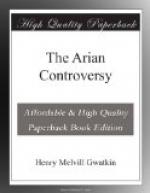Julian met at the feet of Proaeresius. They all
did credit to his eloquence, but there the likeness
ends. Gregory disliked Julian’s strange,
excited manner, and persuaded himself in later years
that he had even then foreseen the evil of the apostate’s
reign. With Basil, on the other hand his friendship
was for life. They were well-matched in eloquence,
in ascetic zeal, and in opposition to Arianism, though
Basil’s imperious ways were a trial to Gregory’s
gentler and less active spirit. During the quarrel
with Anthimus of Tyana, Basil thought fit to secure
the disputed possession of Sasima by making it a bishopric.
[Sidenote: 372.] It was a miserable post-station—’No
water, no grass, nothing but dust and carts, and groans
and howls, and small officials with their usual instruments
of torture.’ Gregory was made bishop of
Sasima against his will, and never fairly entered
on his repulsive duties. After a few years’
retirement, he came forward to undertake the mission
to Constantinople. [Sidenote: 379.] The great
city was a city of triflers. They jested at the
actors and the preachers without respect of persons,
and followed with equal eagerness the races and the
theological disputes. Anomoeans abounded in their
noisy streets, and the graver Novatians and Macedonians
were infected with the spirit of wrangling. Gregory’s
austere character and simple life were in themselves
a severe rebuke to the lovers of pleasure round him.
He began his work in a private house, and only built
a church when the numbers of his flock increased.
He called it his Anastasia,—the church
of the resurrection of the faith. The mob was
hostile—one night they broke into his church—but
the fruit of his labours was a growing congregation
of Nicenes in the capital.
[Sidenote: Theodosius Emperor in the East (379).]
Gratian’s next step was to share his burden
with a colleague. If the care of the whole Empire
had been too much for Diocletian or Valentinian, Gratian’s
were not the Atlantean shoulders which could bear
its undivided weight. In the far West, at Cauca
near Segovia, there lived a son of Theodosius, the
recoverer of Britain and Africa, whose execution had
so foully stained the opening of Gratian’s reign.
That memory of blood was still fresh, yet in that
hour of overwhelming danger Gratian called young Theodosius
to be his honoured colleague and deliverer. Early
in 379 he gave him the conduct of the Gothic war.
With it went the Empire of the East.
[Sidenote: End of the Gothic war.]
Theodosius was neither Greek nor Asiatic, but a stranger
from the Spanish West, endued with a full measure
of Spanish courage and intolerance. As a general
he was the most brilliant Rome had seen since Julian’s
death. Men compared him to Trajan, and in a happier
age he might have rivalled Trajan’s fame.
But now the Empire was ready to perish. The beaten
army was hopelessly demoralized, and Theodosius had
to form a new army of barbarian legionaries before




